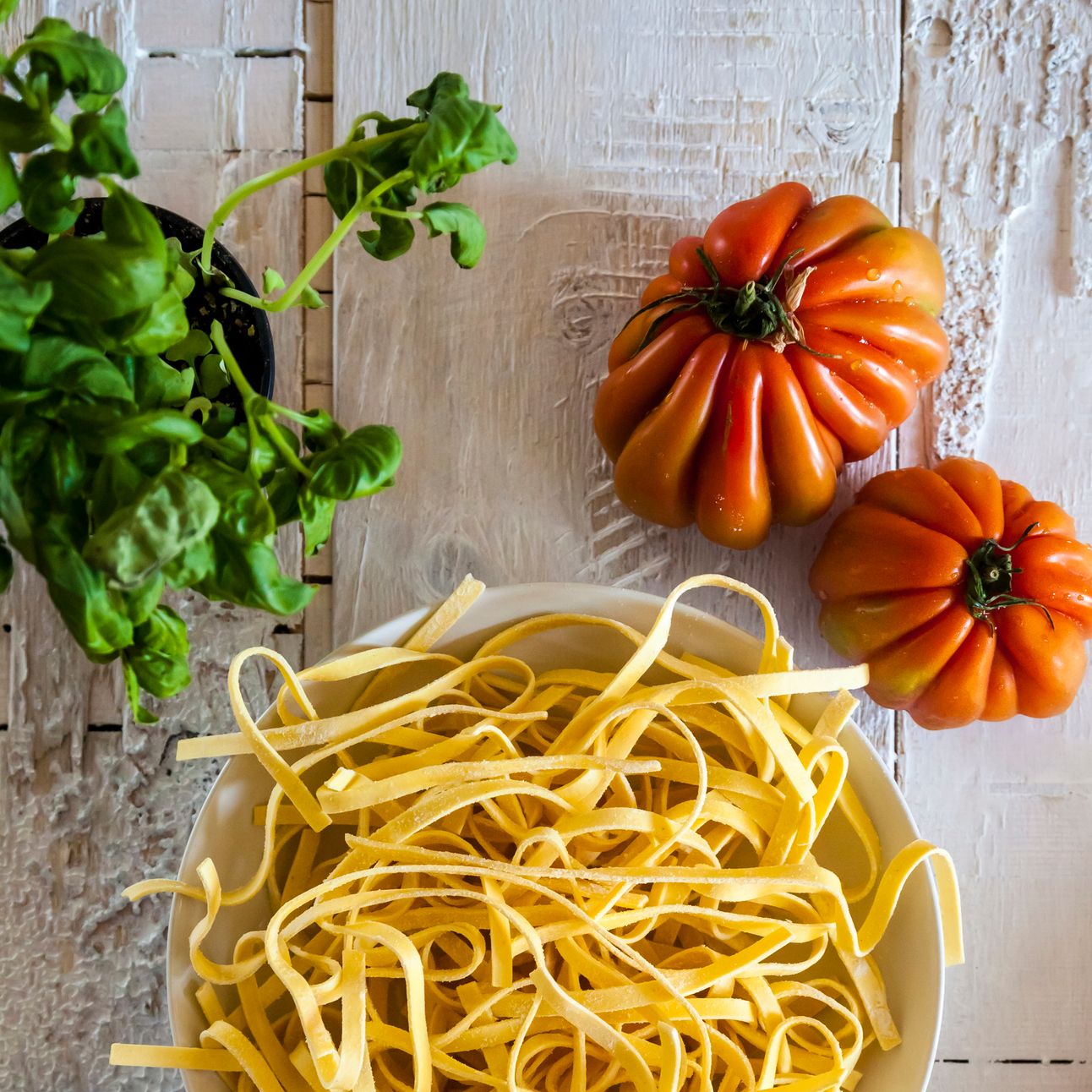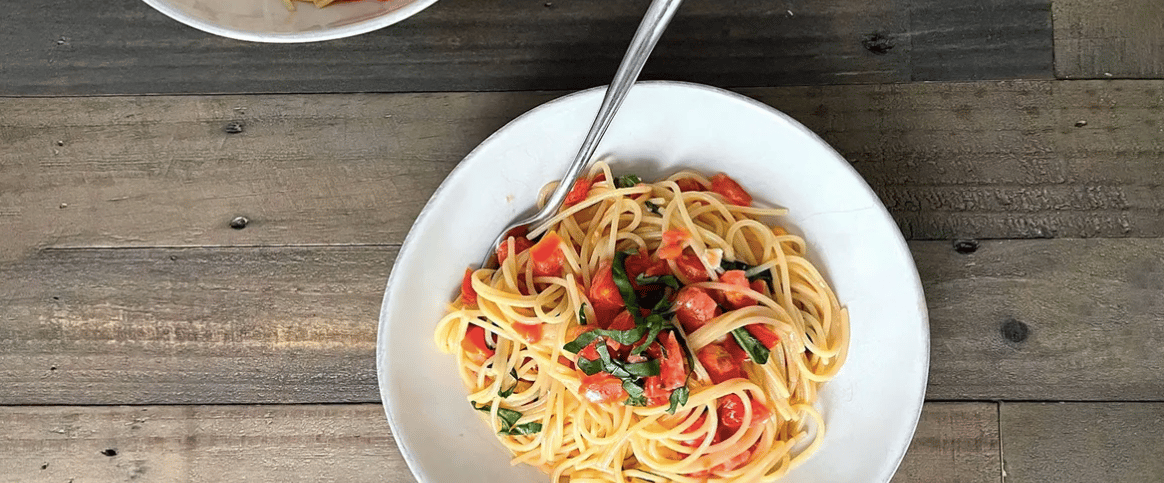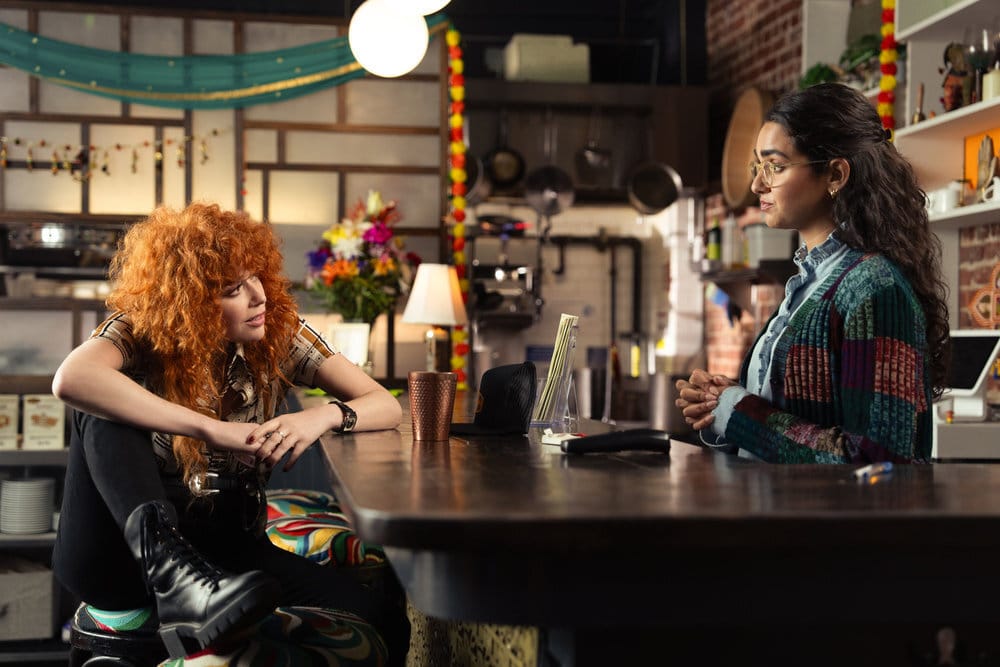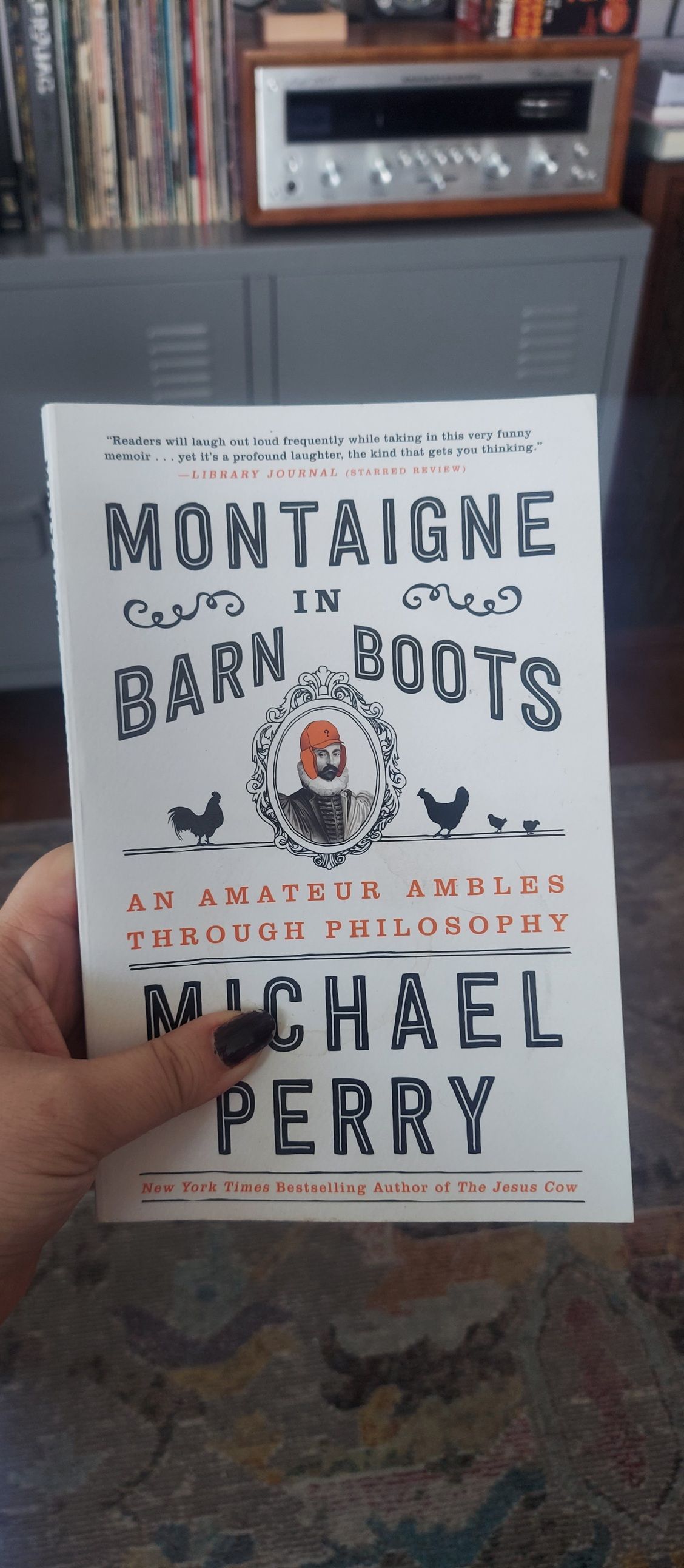- The Bite from Salon.com
- Posts
- No gatekeeping. Just a perfect summer sauce
No gatekeeping. Just a perfect summer sauce
Plus, "Poker Face" and farming philosophy

This sauce doesn’t need a stove — or a secret ingredient

Pasta time (Flavia Morlachetti / Getty Images)
There are dishes I can’t help but romanticize. Not because they’re complicated or labor-intensive — quite the opposite, really. They’re the ones that whisper instead of shout, that make their case quietly, with warmth and confidence and just a hint of seduction. Pasta alla crudaiola is one of them: a summer dish so elemental it feels almost indecent — raw tomatoes, torn basil, soft hunks of mozzarella, all left to mingle in a golden slick of olive oil until the just-cooked pasta warms them into something looser, silkier and more sure of itself.
It’s sultry in the way certain evenings are sultry, when someone you’ve sat across from a hundred times suddenly looks different in the late June light, like maybe you’ve both finally noticed. (Maybe it’s your uncle’s hot, perpetual bachelor of a friend — the one always brings his own wine and whose cologne smells like a birthday candle just blown out: smoke, French vanilla, and an unspoken wish). The air is warm, the wine is sweating through its glass, and the scent of ripe, fragrant tomatoes clings to your fingertips. You don’t cook the sauce. You let it happen.
Maybe that’s the secret. Or maybe there isn’t one at all.
Secrets, secrets, secrets
This feels almost blasphemous to say, in a culture that loves a secret. A secret ingredient. A secret family recipe. A secret hack to make your Tuesday night chicken taste like a five-star chef cooked it while whispering your name. We fetishize secrecy in American cooking — especially the kind passed down through generations. The idea that flavor must be earned, decoded and unlocked. That the real story lives not in what’s shown, but what’s withheld.
And don’t get me wrong — I get it. On a corporate level, it’s what separates fast food institutions like KFC from Kroger’s deli counter; the “eleven herbs and spices” are the stuff of marketing legend. But even at home, secrets have long functioned as shields. The hidden ingredient in your grandmother’s soup wasn’t just paprika; it was the hours she spent tasting and adjusting, planning, stretching, improvising. Domestic labor wrapped in mystery. A soft veil pulled over the work, so the magic could shimmer brighter.
We’ve even built whole plots around it. You know the one: a beloved grandmother, a simmering pot of red sauce, a mysterious ingredient no one can quite name. (It’s oregano, says the cousin. No, a splash of red wine, insists the neighbor. A single anchovy, mutters the Nonna herself, before taking the real answer to her grave.) It’s the stuff of movies and memoirs and about half the internet’s food blogs. And now, Netflix.
In “Nonnas,” a new film based on the true story of Staten Island restaurateur Joe Scaravella — who opened Enoteca Maria with real grandmothers as the rotating chefs — the secret sauce plotline gets the full cinematic treatment. Joe (played by Vince Vaughn) is chasing the memory of his mother’s Sunday gravy, a recipe passed down from his grandmother and revered for its secret ingredient. The reveal doesn’t come until the end, of course. Because what’s a legacy if not a mystery to solve?
At one point, when Joe asks Roberta (a perfectly cast Lorraine Bracco) about the recipe, she waves him off: “That’s like asking to see a woman’s mundate!” In other words: some things aren’t meant to be shared.
And really, can you blame her? After all that time, all that effort, who wouldn’t want to keep a little something for themselves? A magician can’t give away every trick. Not when the act took a lifetime to perfect. But it also frames flavor as something to be protected, not shared. Something earned, not available. And that makes a dish like pasta alla crudaiola feel almost radical: a sauce with nothing to hide.
How the Barefoot Contessa does no-cook sauce
Ina Garten’s Summer Garden Pasta is another prime example of the form. It’s basically the Hampton’s equivalent of pasta alla crudaiola — striped-shirt casual, but with that unmistakable “Barefoot Contessa” polish. Here, the magic happens before the pasta ever hits the pot: “Combine the cherry tomatoes, ½ cup olive oil, garlic, basil leaves, red pepper flakes, 1 teaspoon salt and the pepper in a large bowl. Cover with plastic wrap, and set aside at room temperature for about four hours.”
That rest? It’s not just a pause. It’s a culinary technique — a savory maceration, where the tomatoes release their juices, mingling with basil and salt, becoming something electric. This isn’t “slow cooking” in the stove-on-all-day sense. It’s a dish that asks you to step away. To trust the ingredients to do their thing.
And I have to admit: this part feels revolutionary for me. Because while my common sense (and anxiety) keep me “alert” when the oven or stove is on — fretfully watching, never really leaving the kitchen during winter stews and braises — in this summer sauce I can nap, step outside or even head to the lake and swim while the magic quietly unfolds. It’s a reminder that sometimes, the best cooking isn’t hands-on. It’s hands-off.
It’s the art of letting it happen.
Secrets are sexy. But in the height of summer, I’d rather have a sauce that makes the first move.
How to make pasta alla crudaiola (or something close enough)
There’s no recipe, really — just a vibe. Here’s how to get into it.
Start with tomatoes. Real ones. Ripe, fragrant, maybe a little overripe. Chop them, salt them and let them get juicy in the bottom of a big bowl. This is your sauce base. Don’t rush it.
Add olive oil. More than you think you need. The good kind. The kind that makes your kitchen smell like July.
Toss in something aromatic. A clove of garlic, smashed. Or minced, if you want more bite. Red pepper flakes if you’re in the mood. Maybe a pinch of fennel seeds. You’re building heat without fire.
Herbs. Always. Basil, of course — torn, never chopped. But also mint, dill, parsley, tarragon if you’re a chaos agent. Let your garden (or grocery run) decide.
Now, cheese. The classic is mozzarella — soft hunks or baby bocconcini. But creamy goat cheese melts into the mix like a dream. Brie is untraditional and outrageously good (see more in this week’s recommended recipe). Feta adds snap.
Add something briny. Capers, olives, a swirl of miso, an anchovy or two mashed into the olive oil. You need salt with a point of view.
If you want to throw in a vegetable, go for it. Shaved zucchini. Raw fennel. Corn kernels. Cherry tomatoes roasted just enough to burst. A few halved green beans. It’s your summer. You’re allowed.
Cook pasta. While spaghetti and bucatini are both traditional, I tend to delight in something short and curly — fusilli, orecchiette, shells — shapes that can scoop and cradle. Toss it in while it’s still hot. Let the heat do the last bit of work.
As you might remember, the theme of The Bite this month is, simply, tomatoes. Last week, we slathered ourselves in tomato butter, and next week I’m going long on tomato and eggs, the ultimate power couple. Looking ahead to July, we’ll be diving into our favorite no-cook and low-cook meals — the kinds of dishes that ask very little of you, yet somehow feel like summer distilled. So I’d love to know: what’s your go-to when it’s too hot to cook? What do you eat barefoot, ideally outside, possibly with a cold drink in hand? Drop it in the comments. I’m nosy and taking notes.
Support our food journalism. Become a Salon member today!
What to make this week: Maggie Hennessy's Tomato and Brie Pasta

Tomato and brie pasta (Maggie Hennessy)
Tomato season is the perfect excuse to revisit contributor Maggie Hennessy’s tomato and brie pasta, a clever no-cook sauce that uses heat strategically — from the pasta water and noodles themselves — to coax everything into silky cohesion. Like with pasta alla crudaiola, the technique is simple but smart: garlic is pasted with salt to tame its bite, the tomatoes are salted early to encourage them to release their juices and the brie (briefly frozen first for easier slicing) melts just enough to create a glossy, creamy emulsion when combined with the tomato juices and a splash of pasta water.
Serve it with a crisp rosé and don’t skip the warm bowls, which help everything stay melty and luscious longer.
What we’re reading and watching: “Montaigne in Barn Boots” and “Poker Face”

“One Last Job” Season 2 Episode 7 — Pictured: (l-r) Natasha Lyonne as Charlie Cale, Geraldine Viswanathan as Jenny (Sarah Shatz/Peacock)
Following the season finale of “Clarkson’s Farm” — which, as I mentioned last week, became an unexpected favorite — I’ve found myself craving more offbeat stories where farming is either the lens or the backdrop for something else entirely. So I’m on the lookout now: quirky farm memoirs, thoughtful gardening essays, anything with a little dirt under its nails and a lot of heart. (If you’ve got favorites, please do share in the comments.)
First on my list is Michael Perry’s “Montaigne in Barn Boots: An Amateur Ambles through Philosophy,” a wry, big-hearted book that fuses French Renaissance philosophy with small-town Wisconsin life.
“Based on our backgrounds, I wouldn’t expect to find much in common with Michel de Montaigne. He is permanently deceased in France; I am temporarily alive in Wisconsin,” Perry writes. “He was a nobleman born to nobility; I was born to a paper mill worker and a nurse. He was privately tutored in Latin from the age of two and enrolled in the University of Toulouse to study law when he was fourteen; I matriculated as a barn-booted bumpkin who still marks a second-place finish in the sixth-grade spelling bee as an intellectual pinnacle.”
He continues: “Montaigne composed essays while ensconced in a castle tower overlooking his vineyards. I typed that sentence while ensconced in a room above the garage overlooking a defunct pig pen.”

Another very good book (Ashlie Stevens)
Whether he’s grabbing an electrified fence, failing to fix a truck or feeding chickens, Perry uses each anecdote as a jumping-off point for musings on race, faith, sex, Prince and the quiet labor of becoming a better citizen. It’s part memoir, part ethics class, part love letter to curiosity — and so far it’s making me both laugh and think.
Then, I am, and forever will be, a sucker for “murder of the week” and “monster of the week” shows. I’ve watched every “Columbo” episode multiple times (and I’m firmly in the Sarah Sherman camp here: Peter Falk is God’s gift to women). This spring, I fell down a “The Rockford Files” rabbit hole, and more recently — because I’ll give anything set in Chicago a spin — I finally checked out 1974’s “Kolchak: The Night Stalker,” one of the key influences behind “The X-Files.”
All of which makes me a peak “Poker Face” viewer. I especially loved this week’s episode, “One Last Job,” which I wrote about for Salon.
In an era of ghost kitchens and gig app anonymity, it’s easy to forget that food delivery used to be, well, kind of intimate. You had a place. You had a person. Maybe they knew your usual order. Maybe they handed you your bag with a little eye contact and a smile. It wasn’t groundbreaking — just human.
Which is exactly what makes the “One Last Job,” feel so unexpectedly tender: it sneaks a quiet love story into the middle of a heist, starring a delivery girl, a lonely man and a very well-timed order of samosas.
Until next week,
Ashlie Stevens, senior food editor
Reply